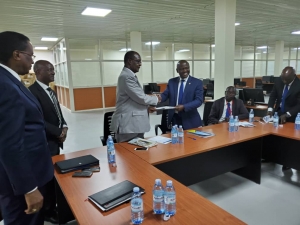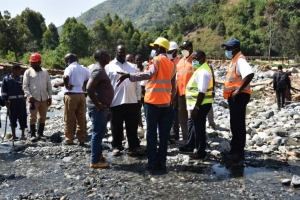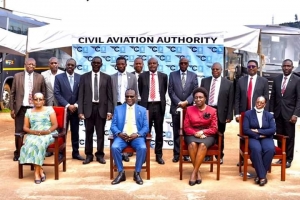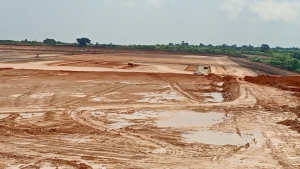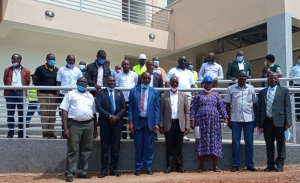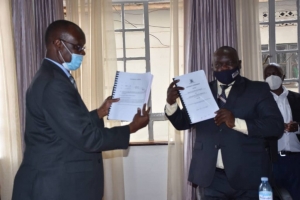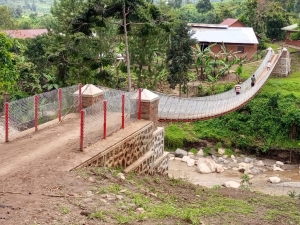URA Hands Over Motor Vehicle Registration Database
Uganda Revenue Authority (URA) has officially handed over to a MoWT team, the warehouse and database for Motor Vehicle Registration records. The team was led by the Permanent Secretary Bageya Waiswa, the Director of Transport, Benon Kajuna and the Commissioner Transport Regulations and Safety, Winstone Katushabe.
The Ministry is expected to streamline, digitize and archive all motor vehicle registration records as part of the transition of the management and administration of Motor Vehicle registration from URA to MoWT.
The warehouse has been renovated under the Ministry’s Public Structures Department.
Commencenent of operations will result into the creation of a proper, reliable and easily accessible database of all Motor vehicles.
Top Leadership Visit to Namanve Vehicle Inspection Station
Hon. Katumba Wamala along with the Minister of State Works Joy kabatsi on Friday visited the SGS vehicle Inspection Center in Namanve. The two were accompanied by the Director of Transport, Benon kajuna, the Chief Mechanical Engineer, Tony Kavuma, the Secretary National Road Safety Council, Ronald Amanyire and key Ministry Staff.
This visit followed Cabinet’s approval of the mandatory and periodic motor vehicle inspection services. Cabinet was in the view that this would improve road safety by ensuring a sound fleet of vehicles on the road. It would also contribute to direct employment opportunities, sustainable environmental protection and also ease the monitoring of the vehicles in the country.
In March 2015, Ministry of Works and Transport awarded SGS a contract to carry out vehicle inspections countrywide on its behalf. The vehicle inspection exercise is carried out under “Safe Drive Uganda” – a road safety measure intended to ensure vehicle roadworthiness and reduce carnage on Ugandan roads.
This mandatory and periodic exercise is aimed at improving road safety by ensuring that motor vehicles are roadworthy and that drivers use safe and well-maintained vehicles. Environmental conservation is an additional goal to prevent vehicle emissions; one of the main sources of air pollution in Uganda.
The Namanve Station is the seventh of seven-fixed vehicle inspection test stations around the country. The first vehicle inspection station in Kawanda started operations on November 28, 2016, the second fixed inspection station in Nabbingo on Masaka road was inaugurated on 3rd May 2017, the third inspection station in Namulanda on Entebbe Road was opened on 31st May 2017, the fourth inspection station in Mbale was opened in September 2017, the fifth inspection station was opened in Mbarara in January 2018 and the sixth inspection station was opened in Gulu in March 2018. Since the mandatory exercise began, nearly 37,000 cars have been inspected at the seven stations.
In addition, mobile units will cover several upcountry locations with sparse vehicle populations to reduce the distance vehicle owners have to travel to the nearest inspection station.
SGS conducts almost 44 million vehicle inspections worldwide for both emissions and roadworthiness.
Restoration of Saaka Swamp Crossing a Priority
Concerns have been raised over the damaged Saaka Swamp Crossing that connects the Districts of Kaliro and Pallisa. The crossing was damaged and made impassable by the recent floods that the country experienced over the last few months. Unfortunately, some lives were lost when a vehicle fell into the swamp waters on 22 February 2020.
The heavy rains that the country experienced last year seriously affected and caused damage on this 3.6 km swamp crossing. These rains were quite unprecedented and are as a result of climate change, which is now a worldwide phenomenon.
It is worth noting that this swamp lies downstream of the Tirinyi Swamp on the Nakalama-Tirinyi-Mbale Highway; a swamp that is crossed by the River Mpologoma, whose catchment area includes the Mt. Elgon area.
The damage to the swamp crossing was not only caused by the heavy flood waters but was aggravated by the many papyrus suds that were carried by the torrents of flood waters. These covered and blocked the culverts causing the water levels to raise and subsequently overtop the road embankment across the swamp. The fast-flowing waters then rapidly washed out the gravel material and subsequently washed away the culverts particularly at the locations where the Mpologoma waters traverse the swamp.
Saaka swamp crossing was constructed by the Ministry of Works and Transport largely using the Force Account Modality.
The swamp crossing was opened to traffic about 2 years ago. Despite having commenced in 2011, these swamp crossing works experienced delays mainly due to budget constraints.
In view of the above, the Ministry is planning for interventions to restore connectivity as soon as water levels reduce. It is anticipated to undertake short term interventions as plans are made for more permanent ones, due to the high costs associated with the latter as provision has to be made for enhanced hydraulic capacity to accommodate the high flood waters, while at the same time ensuring that the bridge or drainage structure has sufficient strength to withstand the hydraulic pressure exerted by the fast moving waters of River Mpologoma. A span bridge and some box culverts are envisaged and the costs for these are high, so an appropriate budget will be required.
During the time that heavy rains were being experienced, the Ministry advised the Road Administrations to ensure that the public was made aware of any disruptions and also carry out emergency interventions at critical locations, where road infrastructure was damaged.
In the case of Saaka swamp the Districts of Kaliro and Pallisa were duly informed. As restitution was not possible at the time, the public was informed that the swamp was impassable. Notices were placed before the swamp to this effect; as well as some stone boulders had been placed across the road.
Unfortunately, on 22 February 2020, a driver ignored advice from the local community not to proceed along this road and even circumvented the stone boulders that had been placed across the road and very regrettably ended up falling into the waters.
To avoid the repeat of such disastrous incidents, murram stacks were immediately dumped across the road on both approaches, so that a vehicle cannot at all be able to proceed to the damaged section of the swamp crossing.
The Ministry is having a challenge with restoring connectivity over many crossings that suffered damage due to the recent heavy rains. The Ministry has compiled submissions made by the various Road Administrations and come up with the cost estimates; which have been submitted to higher authorities. Unfortunately, to date no funds have been allocated towards addressing these failures on the road infrastructure due to budget constraints.
As far as Saaka swamp crossing is concerned, its intervention is being prioritised by the Ministry as soon as water levels go down and funds are secured.
The loss of lives however, is very regrettable and all District Local Governments are urged to erect barriers and also continuously monitor their road networks where the road infrastructure has been damaged rendering them impassable/too dangerous to traverse.
Launch of The Traffic and Road Safety Act, 1998 (Amendment) Act, 2020
The Traffic and Road Safety Act, 1998 (Amendment) Act, 2020 was launched on Thursday 28th May at the Ministry of Transport and Works.
Speaking at its launch, the Minister for Works and Transport, Gen. Katumba Wamala said the new law will help reduce chaos but also hold reckless road users culpable for their acts and misbehavior.
“The act provides for a demerit point system where points are attached to the driving license. The points can be deducted if the holder is convicted of certain traffic offenses prescribed under regulations,” the Minister said.
According to the law assented to by President Museveni on May 22, 2020, drivers will have opportunity to upgrade licenses without going back to driving schools and receive licenses with longer validity.
The amendment also introduced among other things driving licenses with a 5 year validity, demerit points that could lead to loss of a driving license among a reckless drivers and garage and repair facilities to be registered.
The law will also see registration of garages and tech-based transport service providers such as safe Boda and uber.
“Transport network providers using online digital platforms such as Uber, Bolt, Safe Boda shall be licensed and regulated to ensure that they are safe, secure, are efficient and that they comply with their tax obligations,” Gen.Katumba Wamala said.
All drivers will also be required to complete all vehicle transfers to avoid future complications in case vehicles they sold are involved in any criminal incidents.
Minister of State for Works leads a Technical team on a site visit to the floods ravaged areas of Kasese
Peter Lokeris, the State Minister of Works led a technical team including the Engineer in Chief, Samson Bagonza on a two-day tour of the flood ravaged areas of Kasese. The region experienced insurmountable damage to both infrastructure and livelihoods when the rivers of Nyamwamba, Lhubiriha. Nyamugasani and Mubuku burst their banks.
The damages included the Mpondwe Lhubiriha bridge that links Uganda to DRC, Isango bridge along Kithoma-Kiraro road, the Nyamugasani lower bridge along Rwentare-Katwe-Katojo road. The Kasese-Kilembe road and Kyanjuku Bridge were also washed away.
The Kilembe Mines Hospital as well as the Kilembe mines machine shops and offices were also severely damaged, the roads leading to and from the mines and the communities are all covered in boulders.
The Ministry is working with the Local Authorities and Uganda National Roads Authority to spearhead emergency action and mitigation measures. Clearing the boulders to pave way for traffic and to find lasting solutions to river management in the region.
Multi-stakeholder efforts are underway to formulate long term River Management strategies. In the meantime, the Ministry has provided more heavy-duty machinery to clear the boulders, the Force Account Division has been sent in to assess the damages in the hard to reach areas. The team, along with the District heads will spearhead emergency action and mitigation measures.
Equipment to open up the drainage systems which have been clogged with debris and silt have also been dispatched.
Corporate Social Responsibility efforts by a range of stakeholders has been received by the District heads, Mota Engil, the contractor for Katungulu-Ishaka road pledged to carry out an assessment and intervene accordingly.
The Honorable Minister concluded the tour by remarking that there is a great need to study the trends and causes of the rivers floods in order to effectively find lasting solutions.
UCAA new Board of Directors gets inaugurated
The Minister of Works and Transport, Hon. Gen. Katumba Wamala, has today (June 24, 2020) inaugurated a new Board of Directors to oversee the performance of the Authority. Justice Steven Kavuma is the new Chairman of the Board of Directors taking over from Eng. Edward Mike Ndawula.
His appointment and that of the other Board Members was announced on June 3, 2020 following the approval of the appointments by Cabinet. The inauguration ceremony, which also doubled as a farewell to the out-going members of the Board in recognition of services rendered in the last three years was held at the Ministry of Works and Transports Central Mechanical Workshop.
The other new members of the Board are Mr. Lubowa Moses Paul, Ms Ethel Kamba, Dr. Alayo Ocero and Mr. Thomas James Kiggundu. Board Members who served on the last Board and were returned are Hajji Zubair Musoke, Mrs. Angela Kiryabwire Kanyima and Mr. James Kubeketerya. The Board will serve a term of three years in office.
The Ministry’s Top Leadership Inspect Kabaale (Hoima) International Airport
The Minister of Works & Transport, Hon Gen. Katumba Wamala, Minister of State for Works, Hon. Peter Lokeris and the Minister of State for Transport, Hon Joy Kabatsi visited and inspected the ongoing works at Kabaale (Hoima) International Airport on Thursday, June 25, 2020.
The Ministers were accompanied by the Ministry’s Permanent Secretary, Mr. Bageya Waiswa, the Director of Transport Mr. Benon Kajuna, the UCAA Director Air Navigation Services, Mr. Richard Ruhesi and the General Manager, Regional Airports, Mr. Wonekha Samuel..
Project progress is as follows; Period of time elapsed 43.82%, Planned progress of works 44.86%, Actual progress of Works 42.91% The project was moving ahead of schedule prior to the COVID-19 imposed lockdown. It is now anticipated that the contractor will try to catch up on lost time.
The Airport has been designed and is being constructed to handle cargo of up to 140 tonnes with a runway stretching 3.5 meters in length with a threshold width of 45 meters.
Hand over of the first phase of Katuna One Stop Border Post
The Permanent Secretary, Bageya Waiswa presided over the hand over of the first phase of Katuna One Stop Border Post to the lead Agency, Uganda Revenue Authority.
The Katuna OSBP links Uganda to Rwanda and is the sixth OSBP implemented to facilitate trade in the region, promote prosperity and regional integration.
The Uganda Revenue Authority Acting Commissioner Customs, Mr Abel Kagumire received the keys to the Katuna One Stop Border Post (OSBP) officially bringing the number of operational OSBPs in Uganda to Six.
An OSBP is a border facility that combines two stops for national border control processing into one thereby consolidating border control functions in a shared space for exiting one country and entering another significantly cutting down on time spent in cargo clearance across borders.
The permanent Secretary remarked that the Government has allocated six billion for the construction of Phase II. The second phase of the project encompasses tarmacking of the No-mans land road, the parking area and fencing off the border post. Katuna OSBP joins Mutukula, Busia, Malaba, Elegu and Mirama Hills OSBPs in a move that can only guarantee enhanced trade facilitation for Ugandan traders and for those in the great lakes region
The signing of the contract for the Uganda Driver Licensing System between Ministry of Works & Transport and Uganda Security Printing Company (USPC)
The Permanent Secretary, Bageya Waiswa on the 15th of October, 2020 signed a new Contract for the Uganda Driver Licensing System. The contract was awarded to Uganda Security and Printing Company (USPC).
The same ceremony saw the Permanent secretary handover part of the Uganda Railways Corporation office premises designated for the issuance of Driving Licenses. The offices have been remodeled to suit the requirements for the issuance of driving permits which includes sufficient parking space, waiting areas and service desks among others.
He noted that the Government is making deliberate efforts to automate its processes to improve service delivery. “The new Uganda Driver Licensing System is one of them; USPC is taking over at a time when the issuance of driving licenses is one of the best services in the country receiving tremendous reviews”.
“Our expectations are, USPC to take this service to the next level way above where it is in line with the Service Level Agreement” stressed Bageya.
The contract will take immediate effect after signature but the issuance of Driving Licenses commences on 1st December 2020.
The Ministry, in a bid to curb road carnage has put in place a number of measures, including a robust and efficient computerized driving license system that produces a driving license within an hour but also minimizes forgeries.
During the Negotiations, the Ministry was able to look at the sample card design to be produced by USPC. The card is ISO compliant. It can be used in EAC, SADC and COMESA regions, even at a Global level.
Upon execution of this Contract, the Ministry, together with USPC will embark on the following activities with immediate effect to ensure a successful launch on 1st December 2020:
Pre-inspection of the Hardware
Complete Data migration from UCDP to UDLS
Final User Acceptance Testing of the new Software
Card Testing at an accredited ISO laboratory
Gazetting of the new driving license
Recruitment of Staff
Communication Strategy – Training and sensitization
Decommissioning process with FACE for all the driving license stations.
Kasese District receives first suspended cable foot bridge
The Ministry of Works and Transport in partnership with an International NGO, Bridges to Prosperity, are building safe and efficient suspended bridges over impassable rivers am the rural communities.
Under this project 8 such bridges have been constructed in the country; of these, seven are located in the Elgon region. The communities of Kitholu and Karambi Sub Counties with great gratitude received Kyabayanze foot bridge crossing over Lhubiriha River.
During the handover ceremony held at Kituro Secondary School, the Karambi Village Sub-County Chief noted that 11 lives had been lost at the crossing point since May when floods washed away the main bridge.
The suspended foot cable bridge project designs locally appropriate bridges that provide safe and cost effective access to healthcare, education and markets to the communities.
The LC2 Chairperson Kisolholho Parish, Uziah Syahungene said that the bridge was very timely and well situated at the main path linking both sub Counties to markets, healthcare and numerous social services.
kituro Secondary School which is located at the bank of River Lhubiriha was cut off from the community owing to the lack of a bridge. The School’s deputy headmaster, Mayan Gerald, said that the school is the greatest beneficiary of the bridge with more than a half of it’s students coming from across.
“The school had attempted to build a makeshift foot bridge which unfortunately was very dangerous. Whenever the river would flood school children wouldn’t be able to attend classes thus discouraging many learner’s”. He added.
Construction of Kyabayanze Bridge commenced in July, 2020 and was completed in September. The bridge is the first in the region and the longest in the country at 63metres long at a total cost of 117million Ugx.
Eng Zirimenya Andre, a Senior Engineer with the Ministry of Work and Transport explained that the project is still carrying out needs assessment in the region to ensure proper allocation and distribution of bridges. He also added that the Ministry is committed to restoring a vehicular bridge that was destroyed by the floods in May.
The government entered into a partnership with Bridges to Prosperity in 2017 to design and construct cable foot bridges in hilly and flood prone rural areas. Under the partnership, the government and Bridges to Prosperity split the costs of constructing the bridges 50/50.

